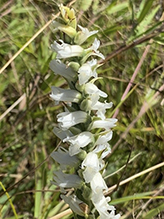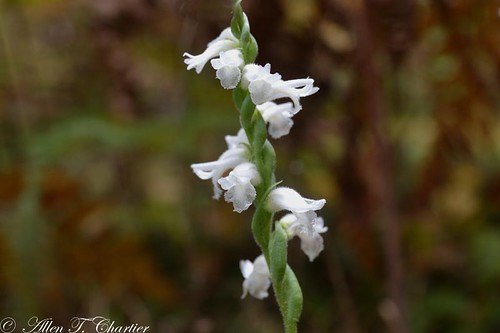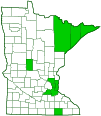Sphinx ladies’ tresses
(Spiranthes incurva)
Conservation • Wetland • Description • Habitat • Ecology • Use • Distribution • Taxonomy
Description |
||
Sphinx ladies’ tresses is a 4″ to 16″ tall, erect, perennial forb that rises on a single stalk from a tight cluster of fleshy roots. There are usually 2 or 3, sometimes 4 or 5, grass-like mostly basal leaves which may be withered or present when the plant is in bloom. They are light green, ascending to spreading, linear lance-shaped to linear inversely lance-shaped, 4″ to 8″ long, and 3 ⁄16″ to ⅜″ wide. They taper to a sharp point at the tip. The margins are untoothed. The stems are erect, unbranched, and leafless except for 3 to 6 bracts below the inflorescence, The bracts are alternate, scale-like, sheathing, and hairless. The inflorescence is 2 or 3 intertwined, tightly spiraling, 2″ to 5″ long flower spikes at the top of the stem with 20 to 60 individual flowers. The flowers on each spike are arranged in spirals of 3 or 4 flowers per cycle of spiral, rarely in loose spirals of 5 or more flowers per cycle. The spirals are not evident due to the intertwining of the spikes. The spikes are light green and moderately hairy. Each flower is subtended by a scale-like, egg-shaped to lance-shaped bract. The flowers are about ½″ long and abruptly nodding at the base. There are 3 white to cream colored or ivory petals and 3 similar petal-like sepals. The upper 2 petals converge with but do not fuse with the upper sepal to form a hood over the united filaments and style (column). The tips of the upper petals and sepal curve upward slightly. The lower petal forms an egg-shaped lip that arches strongly downward. The central portion of the lip is sometimes slightly yellowish and is constricted near the middle. The lip is crisped at the tip. The lateral 2 sepals are linear- lance-shaped, straight or slightly spreading, not recurving, often slightly ascending. The margins of the lateral sepals are rolled inward. The flowers are not scented. |
||
Height |
||
4″ to 16″ |
||
Flower Color |
||
White to cream colored or ivory |
||
Similar Species |
||
Great Plains ladies’ tresses (Spiranthes magnicamporum) stems are leafless at flowering. The lateral 2 sepals are shaped like a pair of cow’s horns. The central portion of the lower lip is never constricted. The flowers are almond-scented. |
||
Habitat |
||
Moist. Prairies, bogs, fields, ditches. Full sun. |
||
Ecology |
||
Flowering |
||
July to September |
||
Pests and Diseases |
||
|
||
Use |
||
|
||
Distribution |
||||
|
Sources |
|||
| 9/6/2022 | ||||
Nativity |
||||
Native |
||||
Occurrence |
||||
|
||||
Taxonomy |
|||
| Kingdom | Plantae (Plants) | ||
| Division | Tracheophyta (Vascular Plants) | ||
| Subdivision | Spermatophytina (Seed Plants) | ||
| Class | Liliopsida (Monocots) | ||
Order |
Asparagales (Agaves, Orchids, Irises, and Allies) | ||
Family |
Orchidaceae (orchids) | ||
| Subfamily | Orchidoideae (orchidoid orchids) | ||
| Tribe | Cranichideae | ||
| Subtribe | Spiranthinae | ||
Genus |
Spiranthes (ladies’-tresses) | ||
| Species Complex | Spiranthes cernua complex (nodding ladies’ tresses complex) | ||
Ancient hybridization between species in the Sprianthes genus has evolved genetically distinct but morphologically overlapping species. Spiranthes cernua has been long known to be a species complex with overlapping characteristics that make identification to the species in the field or in the lab difficult or impossible. A recent study (Pace and Cameron, 2017) clarified the species boundaries within the Spiranthes cernua species complex using molecular DNA sequences and morphological variation. The study resulted in the description of three new species, a new hybrid, and a much narrower concept of the species Spiranthes cernua. The Upper Midwestern ladies’ tresses formerly included in the species Spiranthes cernua are now assigned to the new species Spiranthes incurva. |
|||
Synonyms |
|||
Ibidium cernuum Spiranthes cernua var. incurva |
|||
Common Names |
|||
Sphinx ladies’ tresses |
|||
Glossary
Bract
Modified leaf at the base of a flower stalk, flower cluster, or inflorescence.
Column
The united filaments and style of an orchid. The structure formed by the united filaments of plants in the Mallow family.
Linear
Long, straight, and narrow, with more or less parallel sides, like a blade of grass.
Sepal
An outer floral leaf, usually green but sometimes colored, at the base of a flower.
Sheath
The lower part of the leaf that surrounds the stem.
Visitor Photos |
|||||
Share your photo of this plant. |
|||||
| This button not working for you? Simply email us at info@MinnesotaSeasons.com. Attach one or more photos and, if you like, a caption. |
|||||
Julie Calligure |
|||||
 |
|||||
MinnesotaSeasons.com Photos |
|||||
|
|||||

Slideshows |
||
| Spiranthes incurva (Sphinx ladies-Tresses) Allen Chartier |
||

|
||
About
Formerly Spiranthes cernua (Northern Ladies Tresses) |
||

Visitor Videos |
|||
Share your video of this plant. |
|||
| This button not working for you? Simply email us at info@MinnesotaSeasons.com. Attach a video, a YouTube link, or a cloud storage link. |
|||
Other Videos |
|||
| piranthes incurva, the Sphinx ladies' tresses Orchids of the Oak Openings |
|||
About
Sep 5, 2019 195 views Sep 5, 2019 Spiranthes incurva, the Sphinx ladies' tresses, is one of the two new orchids added to the Oak Openings species list, pursuant to the 2017 clarification and reclassification of the Spiranthes species complex by Matthew Pace and Kenneth Cameron. |
|||
| Spiranthe sphinx/Sphinx ladies' tresses (Spiranthes incurva) Dominique Lalonde Films Nature |
|||
About
Jul 21, 2021 Découvrez les fleurs sauvages du Québec. |
|||

|
Created: Last Updated: © MinnesotaSeasons.com. All rights reserved. |


